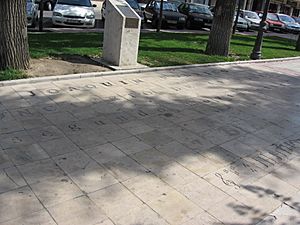Concierto de Aranjuez facts for kids

The Concierto de Aranjuez is a very famous piece of music for classical guitar and orchestra. It was written by the Spanish composer Joaquín Rodrigo in 1939. This concerto is Rodrigo's most well-known work. It helped him become one of the most important Spanish composers of the 20th century.
Contents
What Inspired the Music?
The Concierto de Aranjuez was inspired by the beautiful gardens of the Royal Palace of Aranjuez. This palace was a spring getaway for Spanish kings. It was first built in the 1500s by King Philip II. Later, it was rebuilt in the 1700s by King Ferdinand VI.
Rodrigo wanted the music to make listeners feel like they were in another time and place. He wanted them to imagine the sounds of nature in the gardens. He said the concerto captures "the smell of magnolias, the singing of birds, and the gushing of fountains."
For many years, Rodrigo and his wife, Victoria, kept quiet about what inspired the second movement. Some people thought it was about the bombing of Guernica in 1937. But Victoria later shared that it was about their happy honeymoon days. It also reflected a very sad time for them personally. Rodrigo wrote the music in 1939 while he was in Paris.
Rodrigo dedicated this special concerto to a guitarist named Regino Sainz de la Maza. Even though Rodrigo was nearly blind from age three and played the piano, not the guitar, he perfectly captured the spirit of the guitar in Spanish music.
Music and History in Spain
In 1939, the Spanish Civil War had just ended. This was the start of a time when Francisco Franco was the dictator of Spain. Music performed in Spain during this time often had to support the government. The Concierto de Aranjuez celebrated a historical palace and its gardens. This fit well with the government's plan to honor Spanish history.
How the Music Was Written
Rodrigo wrote the concerto in early 1939 in Paris. This was just before World War II began. It was the first time Rodrigo wrote music for guitar and a full orchestra. It's unusual for a guitar to play with a big orchestra. But Rodrigo made sure the guitar's sound was never lost.
First Performance
The Concierto de Aranjuez was first played on November 9, 1940. This happened at the Palau de la Música Catalana in Barcelona, Spain. Regino Sainz de la Maza was the guitarist. The Orquesta Filarmónica de Barcelona played with him. César Mendoza Lasalle conducted the orchestra.
The concerto was first performed in Madrid on December 11, 1940. The same guitarist played. The first time it was played in the United States was on November 19, 1959. Rey de la Torre was the soloist, and the Cleveland Orchestra played.
What are the Parts of the Music?
This concerto has three main parts, called movements:
- Allegro con spirito (fast and lively)
- Adagio (slow and peaceful)
- Allegro gentile (fast and gentle)
The first and last movements are in the key of D major. The famous middle movement is in B minor. Besides the solo guitar, the orchestra includes flutes, oboes, clarinets, bassoons, horns, trumpets, and strings.
First Movement
The first movement starts with the guitar playing a quick, rhythmic tune. It feels very lively and energetic. The music has a Spanish, flamenco-like feel.
- Introduction (guitar)
- 1st theme (1st oboe and 1st violins)
- 2nd theme (guitar, D major to E♭ major)
Second Movement
The second movement is the most famous part. It is slow and has a quiet, beautiful tune. The cor anglais (a type of oboe) introduces the main melody. The guitar and strings play softly with it. The music feels a bit sad or thoughtful. The melody slowly gets more decorated. Later, the music builds up to a big, emotional moment. Then it returns to the main tune, played strongly by the strings. The movement ends calmly with the guitar.
- Introduction (guitar, B minor)
- Theme (English horn)
Third Movement
The third movement is lively and feels like a courtly dance. The rhythm changes between two different patterns. The guitar starts the main tune. The orchestra then plays it in the main key of D major.
- Theme (guitar, B major)
Rodrigo's Special Honor
On December 30, 1991, King Juan Carlos I of Spain gave Joaquín Rodrigo a special title. He became the Marqués de los Jardines de Aranjuez, which means "Marquess of the Gardens of Aranjuez". This was a great honor for the composer of such a beloved piece of music.
See also
 In Spanish: Concierto de Aranjuez para niños
In Spanish: Concierto de Aranjuez para niños


